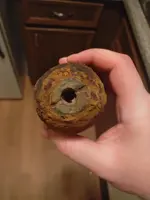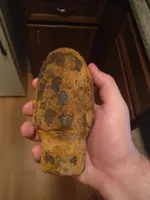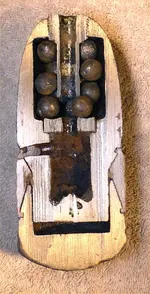Your shell is the nose section of a US 3"-caliber Hotchkiss Type 2 Case-Shot (which means antipersonnel) shell. The other 2 components of this projectile's body, the thick lead belt sabot and the iron base-cup, are missing. It is called a Case-Shot shell because it contained several dozen lead balls or slugs, which would be scattered among enemy infantry troops when this shell burst in the air over their position. This version of Hotchkiss case-shot shell was made from very-early 1863 through the end of the war in 1865.
The Confederates did not manufacture any Hotchkiss projectiles.
You asked what this one is worth:
The three factors which control the value of any relic (and actually, almost everything in this world) are:
Rarity
Condition (which includes "completeness" as in, no missing parts)
Demand (the level of customer interest).
Rarity:
The 3" Hotchkiss Type 2 Case-Shot shell is the 2nd-most-common of all the types of civil war Rifled-Cannon projectiles. Its rarity rating is a 2 on a scale of 1 to 10, with 10 being rarest.
Condition & completeness:
Your shell is an excavated one, showing the effects of laying buried in the dirt under rain and snow for about 150 years. Because it is made of cast-iron, its body will CONTINUE to rust and corrode if it doesn't get properly cleaned and preserved. So, most artillery collectors will not pay as much for one which is still in unpreserved, "as dug" condition.
That being said... the iron which is visible here and there through the rust/dirt encrustation does not appear to be badly corroded. It looks like it would clean up fairly well.
Demand (collector interest level):
Most collectors tend to get more excited about (and desire to own) a rare Confederate shell than a commonplace (and incomplete) yankee-made one. But even if this one was Confederate, being missing about half of its body would still cut its market value in half.
Bottom line about its dollar-value:
As a civil war artillery collector and dealer here in Virginia, I sell 3" Hotchkiss noses in the same condition as yours for $150.
Lastly... I can't tell from the photo whether your shell has been drilled/disarmed through its fuzehole or not. See if you can push a wire down through the fuzehole approximately 4 inches, into the shell's powder-cavity, which as the photo below shows, is in the lower 1/3rd of the nose's body, below the antipersonnel balls. Note, the photo shows somebody drilled through the left side of the shell to get into its powder-chamber and flush out the powder with a water sprayrod.
Even if it hasn't been drilled, you do not need to be afraid of handling it. Unlike 20th-Century artillery shells, which are notoriously "shock-sensitive," an excavated civil war one will NOT explode from being dropped. You might ask, "Where's your proof about that, CannonBallGuy?" The proof: In the past 60 years, we relic-hunters have dug up more than 50,000 civil war shells -- and NOT A SINGLE ONE of them has exploded from being hit by the digger's shovel during the digging-up process. (You don't know you've dug all the way down to the buried shell until you hear your shovel or pick go CLANG on the shell's body.)
That being said.... some civil war shells do still have dry powder in them, which can explode due to extreme heat. (The ignition temperature for blackpowder is 572-degrees Fahrenheit.) A housefire, or an oven, or an overheated drillbit can set off a civil war shell... but dropping it cannot.







